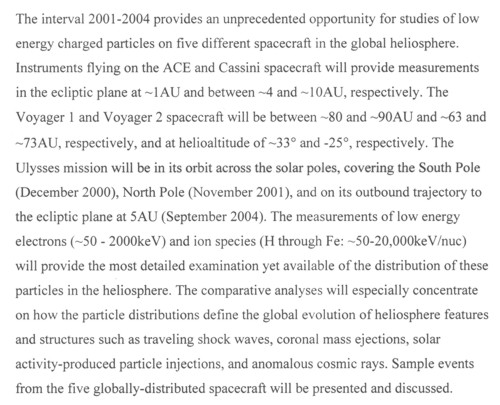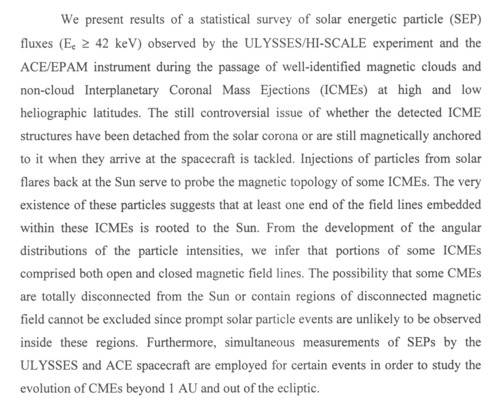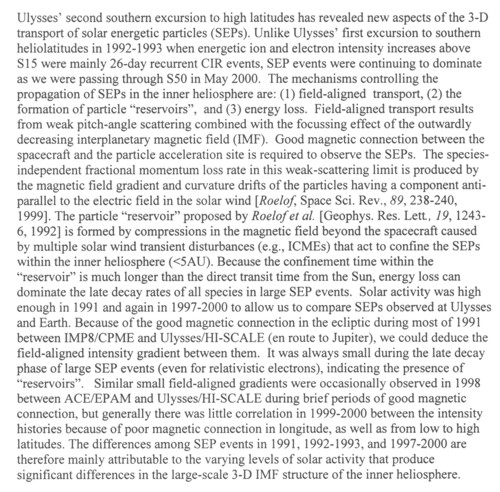Ulysses HISCALE Publications and Presentations
Ulysses HISCALE Contributions to the 34th ESLAB Symposium
S. E. Hawkins III, G. C. Ho, and E. C. Roelof, Comparison of >40 keV Electron Events at High and Low Heliolatitudes: Ulysses/HISCALE and ACE/EPAM, 34th ESLAB Symposium, 2000. Abstract (draft):
|
|
L. J. Lanzerotti, S. M. Krimigis, R. E. Gold, R. B. Decker, E. C. Roelof, and S. E. Hawkins, Low Energy Particles in the Global Heliosphere 2001-2004: 1 AU to 90 AU, 34th ESLAB Symposium, 2000. Abstract (draft):
|
|
D. Lario, D. K. Haggerty, E. C. Roelof, S. J. Tappin, R. J. Forsyth, and J. T. Gosling, Joint Ulysses and ACE Observations of Solar Energetic Particle Events in February 1999 Related to the Same CME, 34th ESLAB Symposium, 2000.
|
Abstract (draft).On February 18, 1999, at 0211 UT a strong interplanetary shock was observed by ACE at 1 AU. This shock was followed 12 hours later by a magnetic field and solar wind structure identified as the interplanetary counterpart of a coronal mass ejection (ICME). A large solar energetic particle (SEP) event was observed in association with the arrival of these structures at ACE. Low energy (<1 MeV) ion intensities peaked with the arrival of the shock, but decreased with the crossing of the ICME, which was also characterized by a bidirectional flow of particles. When Ulysses was located 22 deg. south in heliolatitude and near the central meridian as viewed from Earth, a large SEP event was observed beginning on February 26, 1999, and peaking with the arrival of a solar wind and magnetic field disturbance on March 2, 1999. An ICME structure similar to the one observed by ACE was observed at Ulysses on March 3-5, 1999, together with a decrease of the energetic particle intensity and a sunward flow of particles. We suggest a scenario where a shock driven by the ICME contributed to the SEP events observed at ACE and Ulysses as it moved out from the Sun. The passage of the ICME itself produced particle intensity decreases and changes in their streaming at both spacecraft. |
D. Lario, E. C. Roelof, R. J. Forsyth, and J. T. Gosling, 26-Day Analysis of Energetic Ion Observations at High and Low Heliolatitudes: Ulysses and ACE, 34th ESLAB Symposium, 2000.
|
Abstract (draft).We present a preliminary analysis of 0.060 - 2 MeV energetic ion observations between ACE near Earth and Ulysses during its second pass from January 1999 until mid-2000, as Ulysses moved from 5.2 and 18 deg. S to ~3 AU and 60 deg. S. Data used are from the following instruments: Ulysses (HISCALE, COSPIN, SWOOPS, VHM) and ACE (EPAM, SWEPAM, MAG). In contrast to the long-lived and well-defined 26 day recurrences that were observed for 36 solar rotations throughout Ulysses' entire first southern pass, energetic ion fluxes during the first portion of Ulysses' second polar orbit are highly irregular. Although corotating interaction regions (CIRS) are clearly present in solar wind and magnetic field data throughout the first half of 1999, their effects on energetic ion intensities are quite different from what they were in 1992-93. No dominant and strictly recurrent ion flux increases are observed in association with the arrival of these CIRs. Isolated transient solar energetic particle (SEP) events are also observed, even at high latitudes. These SEPs appear to be responsible for a global filling of the heliosphere with a quasi-steady low-intensity population of energetic ions producing long flux decays at Ulysses. Such SEP events occurred only occasionally during 1993 (during CIRs 6, 15, 18, 23, and 24), but when they occurred, they obscured the recurrences in a manner similar to that observed in 1999-2000. We therefore conclude that the basic differences in the behavior of energetic ion events between the first and second southern passes are due to the short-life of the corotating structure and the higher frequency of SEP events observed in the current epoch. |
O. E. Malandraki and E. T. Sarris, Tracing the Magnetic Topology of Coronal Mass Ejection Events by Ulysses/HISCALE and ACE/EPAM Energetic Particle Observations in and out of the Ecliptic, 34th ESLAB Symposium, Noordwijk, The Netherlands, 3-6 October, 2000. Abstract (draft):
|
|
K. W. Ogilvie and E. C. Roelof, Energetic (60 keV-5 MeV) Ions in Corotating Interaction Regions at Ulysses: 1992-1993 and 1999-2000, 34th ESLAB Symposium, 2000. Abstract (draft):
|
|
M. Pick, D. Maia, S. Edward Hawkins, and Sam Krucker, Solar Origin of Energetic Electron Events and Dynamical Behavior of the Corona, 34th ESLAB Symposium, 2000.
|
Abstract (draft). We investigate the solar origin of energetic collimated electron events observed in situ by EPAM, WIND/3DP and/or HISCALE particle experiments aboard, respectively, the ACE, WIND and ULYSSES spacecraft. These events have been selected during the period 1997-2000. Some of them have been detected at middle and high heliocentric latitudes. Coordinated observations covering a large spectral range provide new insight into the sites of particle acceleration in the corona. The multifrequency Nancay radioheliograph, the Porto radiospectrograph, the WAVES experiment on the WIND spacecraft, and the LASCO coronagraphs aboard SOHO provide the main sources of data. Complementary H alpha and coronagraph observations are also used. Different kinds of electron sites are identified in the corona. They can be located far from the flaring site and accelerated electrons can be injected over a large range of latitude and longitude. The dynamical behavior and the large scale magnetic restructuring of the corona during these events are analyzed. |
E. C. Roelof, The Roles of Field-Aligned Transport, Particle "Reservoirs," and Energy Loss in Controlling the Global Distribution of Solar Energetic Particles in the 3-D Heliosphere, 34th ESLAB Symposium, 2000. Abstract (draft):
|
|
Updated 8/8/19, Cameron Crane
QUICK FACTS
Mission End Date: June 30, 2009
Destination: The inner heliosphere of the sun away from the ecliptic plane
Orbit: Elliptical orbit transversing the polar regions of the sun outside of the ecliptic plane








